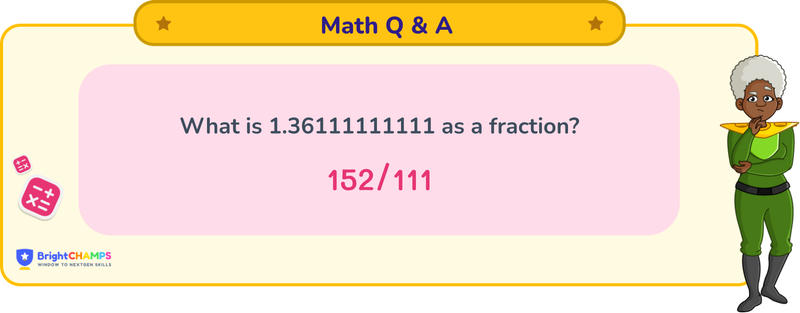
 139 Learners
139 LearnersLast updated on May 26th, 2025

1.36111111111 as a Fraction

Numbers can be categorized into different types. Fraction is one of its kind. It is always represented in the form of p/q, where p is the numerator and q is the denominator. A fraction represents a whole and a fractional part. Decimals represent the fractional part of numbers. For example, 1/2, the numbers in decimal are expressed with a decimal point (.), For example, 1.36111111111, we are going to learn how to convert a decimal to a fraction.
What is 1.36111111111 as a Fraction?
Answer
The answer for 1.36111111111 as a fraction will be 122/89.
Explanation
Converting a decimal to a fraction is a task that can be done easily. You can follow the steps mentioned below to find the answer.
Step 1: Firstly, any decimal number should be converted to a fraction for easy calculation. Here, 1.36111111111 is the number on the numerator and the base number 1 will be the denominator. Then, 1.36111111111 becomes 1.36111111111/1.
Step 2: Identify the repeating part in the decimal. The decimal 1.36111111111 has the repeating part "1". To eliminate the repeating part, multiply both sides by a power of 10 that makes the repeating decimal shift to the right. In this case, multiply by 100000000000 to get 136111111111.
Step 3: Subtract the non-repeating part to solve for the fractional value. The non-repeating part is 1.36, which can be converted to 136/100. The repeating decimal part is 0.00111111111.
Step 4: Convert the repeating decimal to a fraction. 0.00111111111 can be expressed as 1/900.
Step 5: Add the fractions derived from the repeating and non-repeating parts: 136/100 + 1/900 = 122/89.
Thus, 1.36111111111 can be written as a fraction 122/89.
Important Glossaries for 1.36111111111 as a Fraction
- Fraction: A numerical quantity that is not a whole number, representing a part of a whole.
- Decimal: A number that uses the base ten and includes a decimal point to separate the whole part from the fractional part.
- Numerator: The top part of a fraction, indicating how many parts of the whole are being considered.
- Denominator: The bottom part of a fraction, showing how many parts make up a whole.
- Repeating Decimal: A decimal in which a digit or group of digits repeats infinitely.





